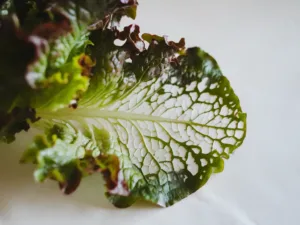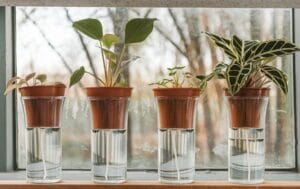Basil is one of the most popular herb plants worldwide. It adds a distinctive flavor to many dishes, from Italian pasta creations to fresh summer drinks. But did you know that basil thrives particularly well in hydroponics? In a controlled hydroponic system, your basil not only grows faster but also develops a more intense aroma. No wonder more and more hobby gardeners are switching to hydroponics to get the best out of their plants!
By forgoing soil and directly supplying nutrients to the roots, you can harvest fresh and robust basil all year round. Growing in hydroponics has another advantage: pests and diseases occur much less frequently. So if you’re ready to unleash the full potential of this aromatic plant, read on to learn how to successfully cultivate basil in your hydroponic setup.
The Best Basil Varieties for Hydroponics
Not all basil is the same. There are numerous varieties that differ in size, color, aroma, and growth characteristics. Some varieties are more robust and particularly suitable for hydroponic cultivation as they grow faster and are more resistant. Others have special flavor nuances that can elevate your herb experience to a new level. Which variety you choose depends not only on your personal taste but also on how much space you have and how intensive you want your care routine to be.
Here are some of the best basil varieties for hydroponics:
- Genovese Basil: The classic basil variety found in many kitchens. It is known for its large, green leaves and intense, sweet aroma. This variety grows quickly and is very robust in hydroponic systems.
- Thai Basil: An exciting variety with a slightly peppery, anise-like flavor, perfect for Asian dishes. The plant itself has smaller, dark green leaves and requires a bit more attention as it is sensitive to temperature fluctuations.
- Lemon Basil: As the name suggests, this variety has a pronounced citrus aroma, making it perfect for refreshing summer drinks or light dishes. Lemon basil grows particularly quickly in hydroponics and is an easy-to-care-for variety.
- Purple Basil: With its striking purple-red leaves, purple basil is not only a visual highlight but also has an intense flavor. This variety brings a spicy, slightly sharp note and is great for salads or pestos. It grows a bit slower in hydroponic systems but can be very productive with proper care.
Choosing the right variety can make a difference in how quickly your basil grows and how intense the flavor becomes. If you’re unsure, try out different varieties to find your favorites!
Suitable Hydroponic Systems for Basil
Not every hydroponic system is equally suitable for basil. Since basil is a herb that grows relatively quickly and doesn’t require much space, you can achieve impressive results with the right systems. Here’s an overview of the best systems for basil in hydroponics:
- NFT System (Nutrient Film Technique): This system is ideal for plants like basil that require a fast and stable water flow. The NFT system works with a shallow, continuous layer of nutrient solution flowing over the roots. Since basil develops shallow roots, it particularly benefits from the constant supply. Another advantage: you can stack the system space-savingly and grow a large amount of basil even in small spaces.
- Deep Water Culture (DWC): In a DWC system, your plants’ roots grow directly in a nutrient solution. This system is particularly stable and well-suited for beginners as it requires little maintenance. Basil grows in a consistently moist environment here, leading to strong, healthy plants. However, you need to regularly check the oxygen content of the nutrient solution to prevent root rot.
- Aeroponics: This is one of the most advanced hydroponic systems. Your plants’ roots hang freely in the air and are regularly sprayed with a fine nutrient solution. Aeroponics offers the fastest growth and highest yield but is also more technically demanding. If you’re an experienced gardener ready to invest in a more complex system, this might be the right choice for you.
The choice of system depends on your space, budget, and technical skills. Beginners are well-advised to start with a DWC system or a simple NFT system, while experienced hydroponic enthusiasts can achieve particularly high yields with aeroponics. Regardless of the system, you should always ensure that your plants receive enough light and a constant supply of nutrients.
Basil Cultivation: Getting Started
Starting basil cultivation in a hydroponic system is easier than you might think. With the right preparation, you can see your first basil plants sprout in no time. The key to success lies in choosing the right seeds, creating the optimal environment, and having a little patience.
The first step is selecting high-quality seeds. Make sure they are fresh and have a high germination rate. Basil seeds are tiny but contain everything the plant needs to start. For cultivation, you can use seedling cubes that you place in special germination boxes or directly in the hydroponic system. Rock wool, coconut fibers, or special germination pads are particularly suitable as they store moisture well and provide support for the roots.
Once the seeds are sown, it’s important to create the right environment. Basil germinates best at temperatures of about 20-25 degrees Celsius. You should also ensure that the seeds receive enough moisture but don’t drown – good ventilation is also crucial. Within 7 to 10 days, the first seedlings will sprout. Once they have developed their first leaves, you can carefully transfer them to your hydroponic system.
Choosing the Right Substrate
In hydroponics, the substrate that supports your plant roots is particularly important. Since there is no soil to provide physical support to the plants, the substrate is the base on which the roots spread. For basil, there are some substrates that are particularly suitable.
- Rock Wool: Rock wool is one of the most commonly used substrates in hydroponics. It retains water well and provides stability to the roots. Another advantage is that it is pH-neutral, which facilitates nutrient absorption. However, you should ensure it doesn’t become too waterlogged, as this can lead to root rot.
- Coconut Fibers: This organic substrate is an environmentally friendly alternative to rock wool. Coconut fibers have excellent water retention capacity and are biodegradable. They also provide good support to the roots and prevent waterlogging.
- Clay Pellets: These lightweight pellets are ideal for supporting the roots while ensuring good aeration. They don’t store as much water as rock wool or coconut fibers but offer excellent oxygen supply, which benefits basil.
Each substrate has its pros and cons. For beginners, rock wool or coconut fibers are often the best choice as they are easy to care for and offer high water retention. Feel free to experiment with different substrates to find out which works best for you and your basil.
Temperature and Humidity for Optimal Growth
For your basil to grow vigorously and aromatically in hydroponics, the right temperature and humidity conditions are crucial. Basil is a heat-loving plant that thrives best at temperatures between 20 and 28 degrees Celsius. If the temperature drops below 15 degrees, growth slows significantly, and the plant can become more susceptible to diseases.
Humidity also plays a role. A relative humidity of 50 to 60 percent is ideal for basil. Too low humidity causes the leaves to dry out, while too high humidity increases the risk of mold and fungal infestation. In a hydroponic system, you have the advantage of being able to control these factors well. Use a humidifier or dehumidifier to create the ideal conditions and ensure good ventilation to prevent mold formation.
Another important detail: basil loves sunlight. In most cases, you should ensure that the plants receive at least 6 hours of sunlight per day. In an indoor setup, artificial lighting, such as LED lamps, can replace sunlight, which is especially beneficial in winter or poorly lit rooms.
Proper Lighting for Robust Basil
Basil is a sun-loving plant, and sufficient light is crucial for healthy, robust growth. If you’re growing your basil in an indoor hydroponic system, you need to ensure that the plants receive enough artificial light, as they should be illuminated for at least 14 hours a day to grow optimally.
The best choice for indoor hydroponics is LED grow lights. These lamps are energy-efficient and provide exactly the right light spectrum basil needs for photosynthesis. There are LEDs specifically designed for plant cultivation that combine blue and red light to promote both leaf growth and flowering – although you’ll rarely want basil to flower, as this can alter the taste of the leaves.
The placement of the lamps is equally important. Ensure that the lamps hang about 30-40 cm above the plants to ensure even light distribution. Light that is too close can burn the leaves, while light that is too far away can slow growth. A practical tip: use a timer to precisely regulate the lighting duration and ensure consistent supply.
pH and EC Levels: Essential for Healthy Plants
In hydroponics, it’s especially important to monitor the nutrient solution, as it acts directly on the plant roots. Two of the most important metrics are the pH level and the electrical conductivity (EC) level. If these values are not in the correct range, your basil cannot optimally absorb nutrients.
- pH Level: Basil prefers a slightly acidic pH level between 5.5 and 6.5. If the pH level is too high or too low, certain nutrients can no longer be properly absorbed, leading to deficiencies. Therefore, it’s important to regularly check the pH level of the nutrient solution and adjust it if necessary with pH-up or pH-down products.
- EC Level: The EC level measures the concentration of dissolved salts (i.e., nutrients) in the nutrient solution. Basil requires a moderate EC level between 1.0 and 2.0 mS/cm, depending on the growth phase. A too low EC level means there aren’t enough nutrients, while a too high EC level can damage the roots and lead to over-fertilization.
Monitoring these values is key to healthy basil cultivation. With a digital pH and EC meter, you can easily and accurately keep track of these parameters. Adjustments to the nutrient solution should be made carefully to avoid stressing the plants.
Fertilizers and Nutrients: What Basil Really Needs
Basil is a hungry plant that requires a constant supply of nutrients to grow vigorously and aromatically. In hydroponics, you have the advantage of being able to add nutrients directly to the nutrient solution, allowing for precise control. But which nutrients are particularly important for basil?
- Nitrogen (N): This nutrient promotes leaf growth and is particularly important for basil, as you primarily harvest the leaves. Adequate nitrogen supply ensures lush, green foliage.
- Phosphorus (P): Phosphorus supports root development and is important for overall plant growth, especially in the early growth phases.
- Potassium (K): Potassium promotes overall plant health and improves resistance to diseases and stress. It also ensures good water regulation in the leaves.
In addition to the main nutrients, basil also needs trace elements like magnesium, iron, and calcium to stay healthy. A balanced hydroponic fertilizer specifically designed for herbs contains all these nutrients in the right ratio.
It’s important to adjust the amount of fertilizer to the growth phase of your basil. In the first few weeks, the plants require less fertilizer as they are still small. As they increase in size, you can correspondingly increase the amount of fertilizer. However, be careful not to over-fertilize, as this can harm the plant and affect the taste.
Harvest Time: When and How to Harvest Basil Correctly
Harvesting basil correctly is an art in itself. The good news: if you do it right, your basil will keep growing back, allowing you to harvest fresh leaves for months. When and how you harvest not only affects the taste but also the further growth of your plant.
The best time to harvest is when your plant has developed at least six to eight pairs of leaves. This is usually about six weeks after placing it in your hydroponic system. It’s important not to harvest too early, as this weakens the plant and slows regrowth.
When harvesting, you should cut the upper leaves just above a leaf node. This encourages the plant to branch out further and grow denser. Avoid simply picking the lower leaves, as this inhibits growth. Another tip: harvest in the morning, as the water content in the leaves is highest then, and the aroma is more intense.
With the right technique, you can harvest regularly for weeks and months without your basil losing strength. The more often you trim the plant, the bushier and denser it will become – and that means more basil for you!
Diseases and Pests in Hydroponics
Even though basil is less susceptible to diseases and pests in hydroponics than in soil, there are still some threats you should keep an eye on. Controlled cultivation in a hydroponic system helps avoid many problems, but your basil is not entirely immune.
- Powdery Mildew: This fungal disease appears as a white, powdery coating on the leaves. Mildew often occurs in high humidity and poor ventilation conditions. To prevent it, ensure good air circulation and control humidity. If mildew occurs, you can remove affected leaves and use natural fungicides.
- Aphids: These tiny, sap-sucking insects can also occur in hydroponics, especially if the system is set up indoors. They suck the plant sap from the leaves, weakening growth. You can naturally combat aphids with ladybugs or beneficial larvae or use a mixture of water and neem oil for control.
- Root Rot: In hydroponics, the risk of root rot primarily arises when the system is poorly ventilated or the nutrient solution lacks sufficient oxygen. You can recognize root rot by a musty smell and discolored roots. To avoid this, ensure sufficient oxygen supply in the water and, if necessary, use an additional aerator.
By regularly checking the plants and taking preventive measures, you can avoid most problems. If you recognize early that something is wrong, you can react quickly and prevent diseases or pests from spreading.
Super Tips for Strong Basil
Growing basil in hydroponics is not only efficient but also incredibly rewarding if you follow a few plant-specific tips. There are some simple yet effective tricks to further improve the growth and flavor of your plants.
- Regular Pruning: As mentioned during harvesting, pruning the plant promotes branching and ensures denser growth. Regularly trim the upper leaves to stimulate growth and keep your plant compact.
- Air Circulation: A well-ventilated growing area or a fan near your basil not only reduces the chances of mold and fungi spreading but also promotes the plant’s overall health. Fresh air encourages strong root growth and supports evaporation.
- Flavor Enhancement through Light: The more light your basil receives, the more intense the aroma of the leaves will be. If you grow your basil outdoors or in a room with plenty of natural sunlight, you’ll find that the leaves are particularly aromatic. Indoor growers can achieve similar results by choosing the right lighting.
By incorporating these tips into your daily care routine, you’ll soon notice how strong and healthy your basil grows. And the best part: you’ll always have fresh basil for your kitchen!
Your Basil Adventure in Hydroponics
You’ve made it! With all the tips and information you’ve gathered in this guide, you’re well-prepared to successfully grow basil in hydroponics. Whether you’re trying out different varieties, finding your perfect hydroponic system, or learning how to create optimal conditions for light, nutrients, and temperature – your basil will thrive under your care.
Remember: hydroponics offers you the opportunity to harvest fresh, healthy, and aromatic basil all year round. It’s a great feeling to go into the kitchen, cut a few leaves from your own basil, and enhance your dishes with them.
So go ahead, start your basil adventure! Whether you’re a beginner or already an experienced hydroponic enthusiast – with basil, you have a plant that guarantees success and joy.







